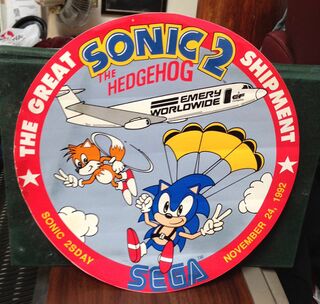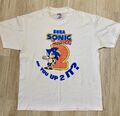Difference between revisions of "Sonic 2sday"
From Sega Retro
m (external link) |
m (formatting) |
||
| Line 1: | Line 1: | ||
[[File:Sonic 2sday shipment badge.jpeg|320px|right|thumb|Sonic 2sday was a significant accomplishment for [[Sega of America]].]] | [[File:Sonic 2sday shipment badge.jpeg|320px|right|thumb|Sonic 2sday was a significant accomplishment for [[Sega of America]].]] | ||
| − | {{sub-stub}}'''{{PAGENAME}}''' was a [[Sega of America]] marketing campaign centered around the Western release date of [[sonic:Sonic the Hedgehog 2|Sonic the Hedgehog 2]] | + | {{sub-stub}}'''{{PAGENAME}}''' was a [[Sega of America]] marketing campaign centered around the Western release date of [[sonic:Sonic the Hedgehog 2|Sonic the Hedgehog 2]], Tuesday, November 24, 1992. Created by Director of Global Marketing [[Al Nilsen]], the campaign was highly promoted, and its success further established [[Sega]] as a household name. |
The name is a portmanteau of the words ''Sonic 2'' and ''Tuesday''. | The name is a portmanteau of the words ''Sonic 2'' and ''Tuesday''. | ||
Revision as of 04:46, 22 April 2021

This teeny-tiny article needs some work. You can help us by expanding it.
Sonic 2sday was a Sega of America marketing campaign centered around the Western release date of Sonic the Hedgehog 2, Tuesday, November 24, 1992. Created by Director of Global Marketing Al Nilsen, the campaign was highly promoted, and its success further established Sega as a household name.
The name is a portmanteau of the words Sonic 2 and Tuesday.
Contents
History
Legacy
Sonic 2sday is the first significant occurance of a synchronized game release date. Previously, games would begin showing up in stores at irregular dates, with some retailers not getting stock until well after others. Sonic the Hedgehog 2‘s American and European releases were locked to a single day, building excitement further by giving buyers a calendar date to anticipate.
The video game industry would later adopt Nilsen’s model as the de-facto standard. Games are generally available on a publically-known date, much like movies. Additionally, video games are often still released on a Tuesday.
Promotional material
Clothing
A commemorative T-shirt distributed internally at Sega of America.
Displays
The decal attached to Emery Worldwide shipping trucks as they delivered games upon the eve of Sonic 2sday.




